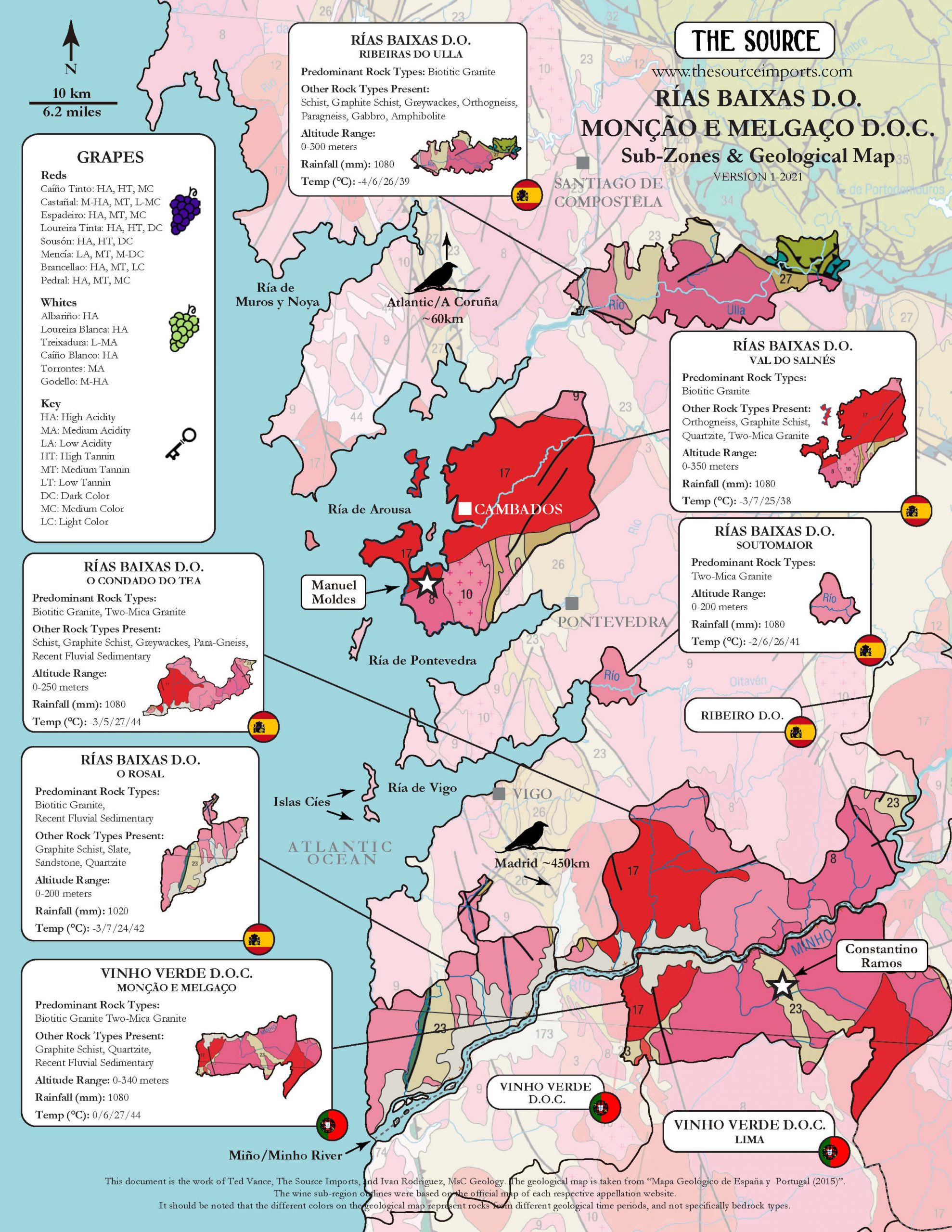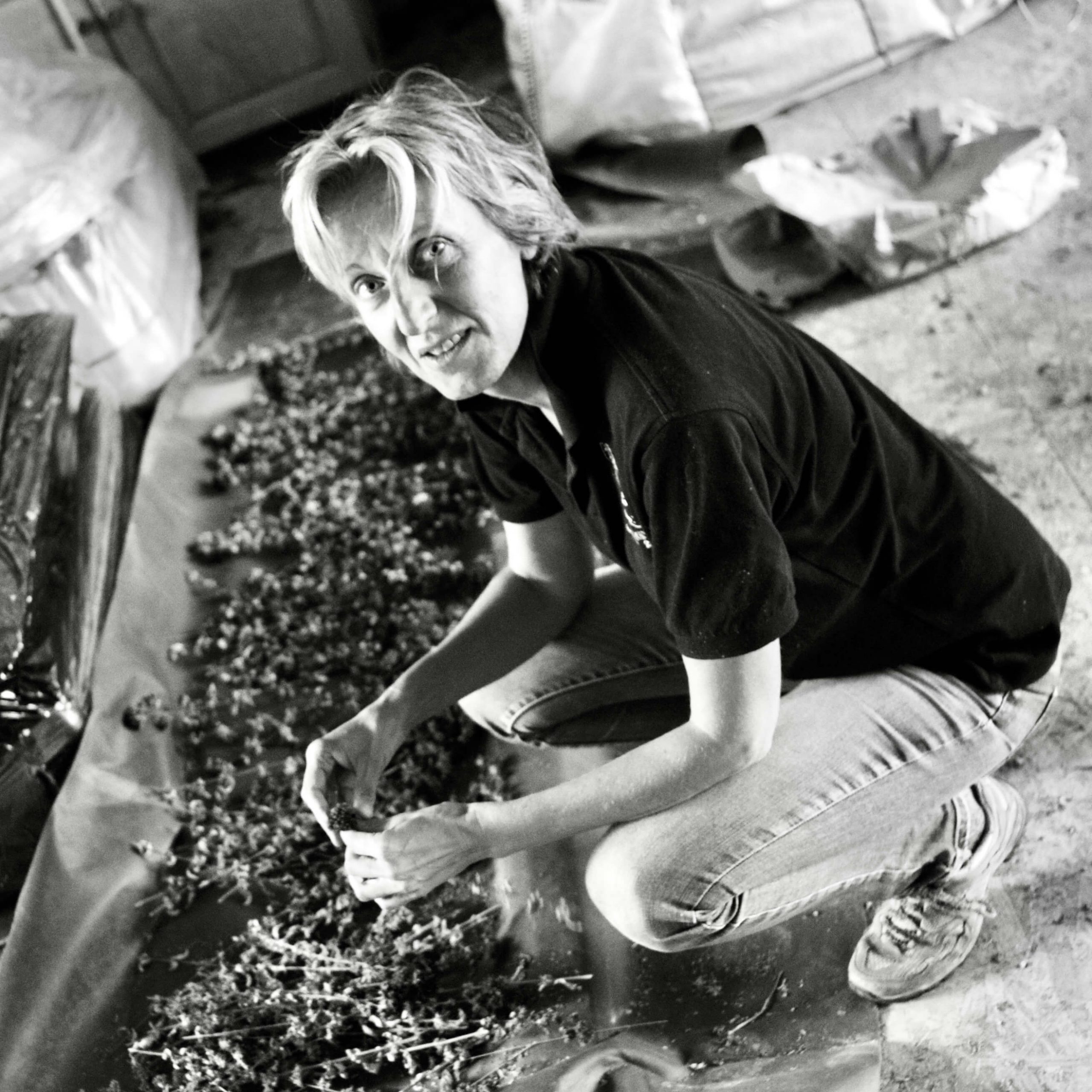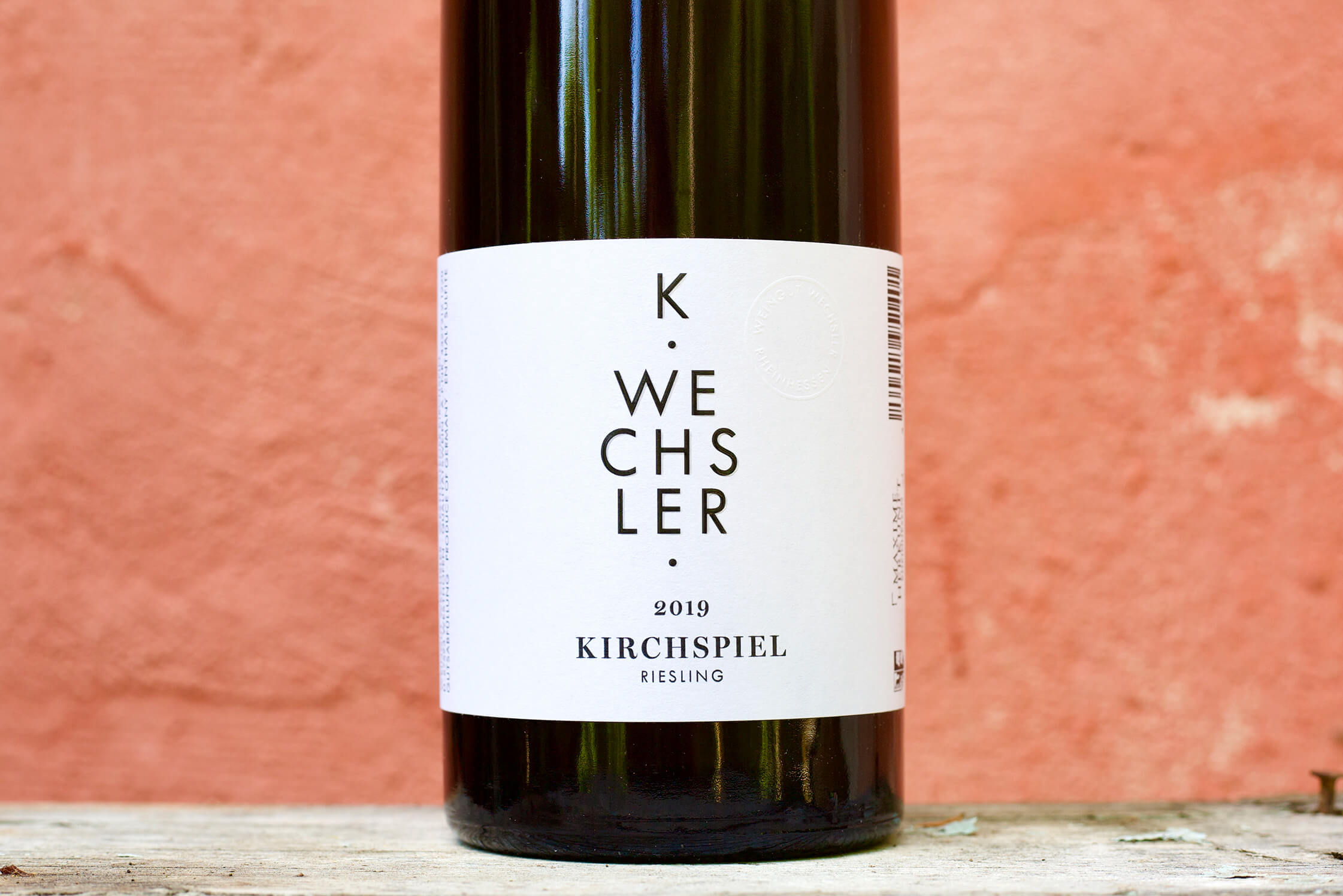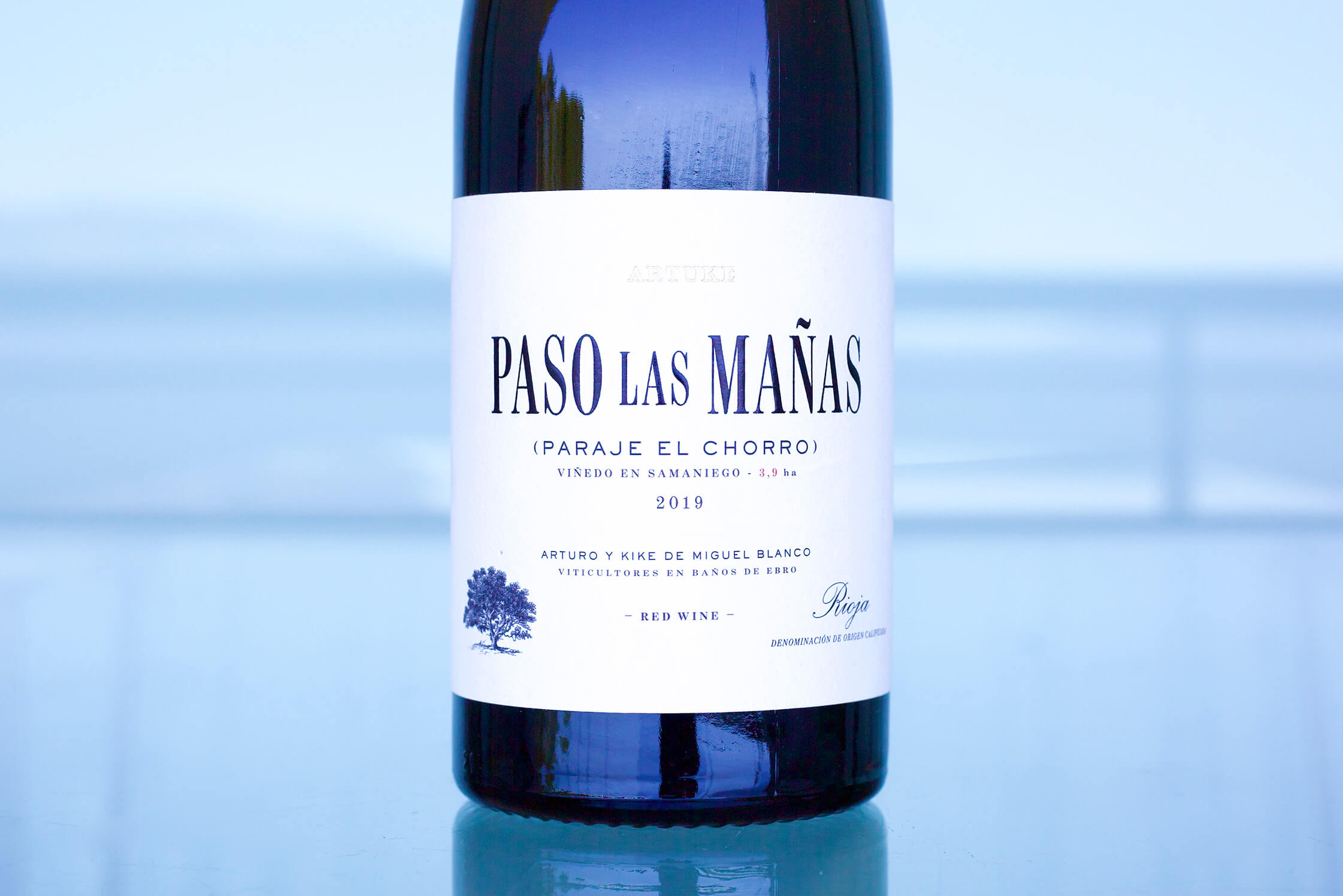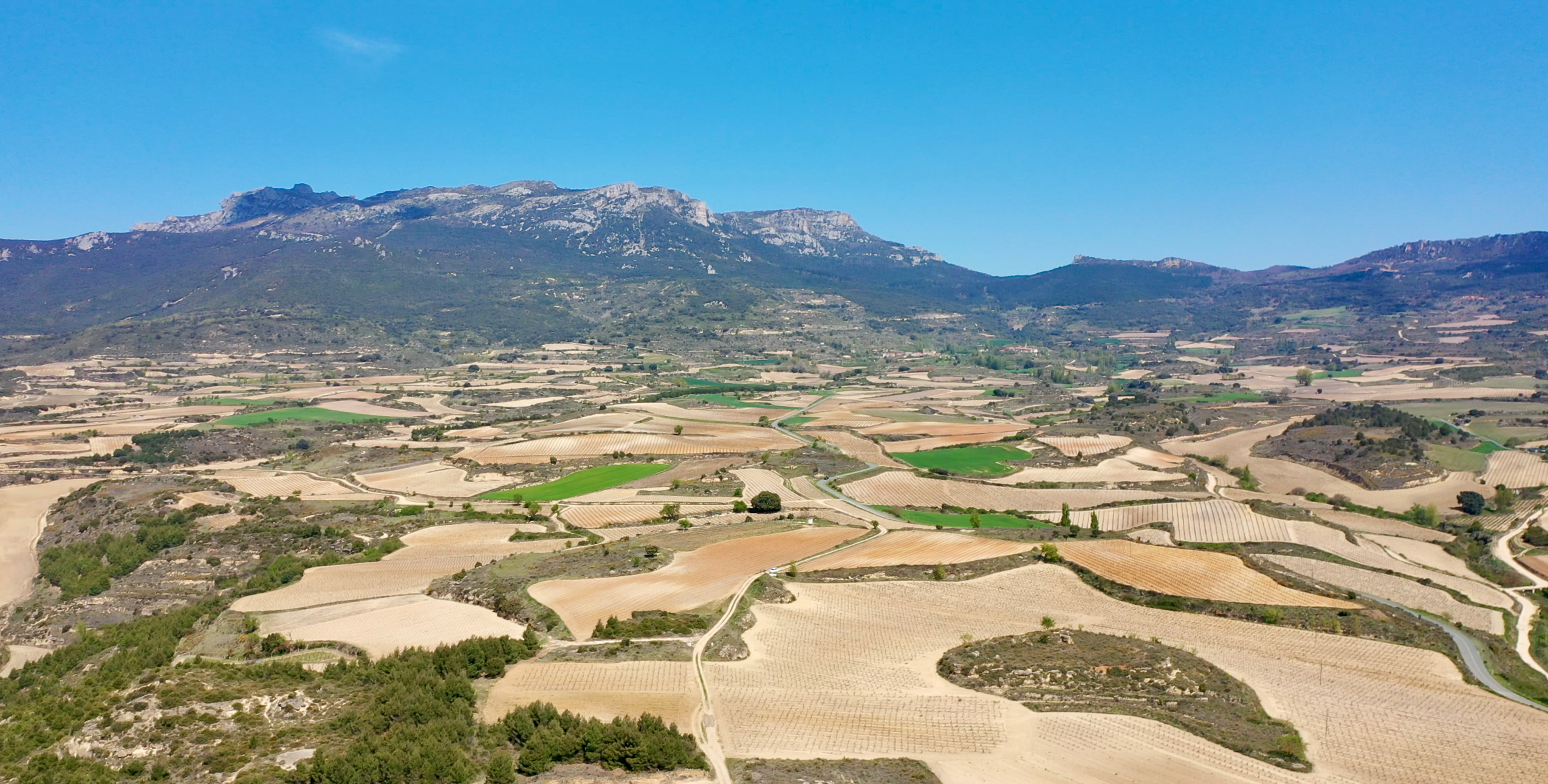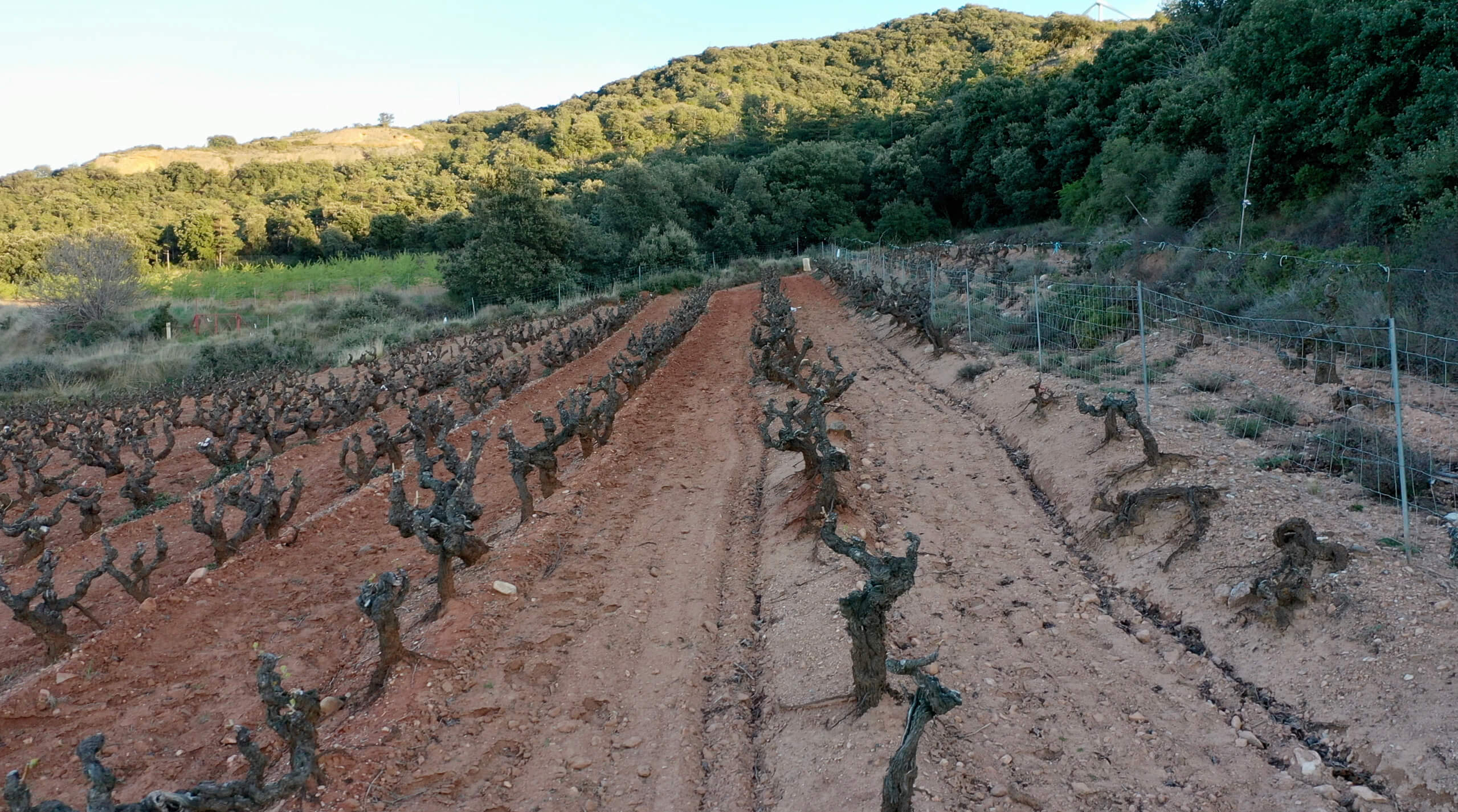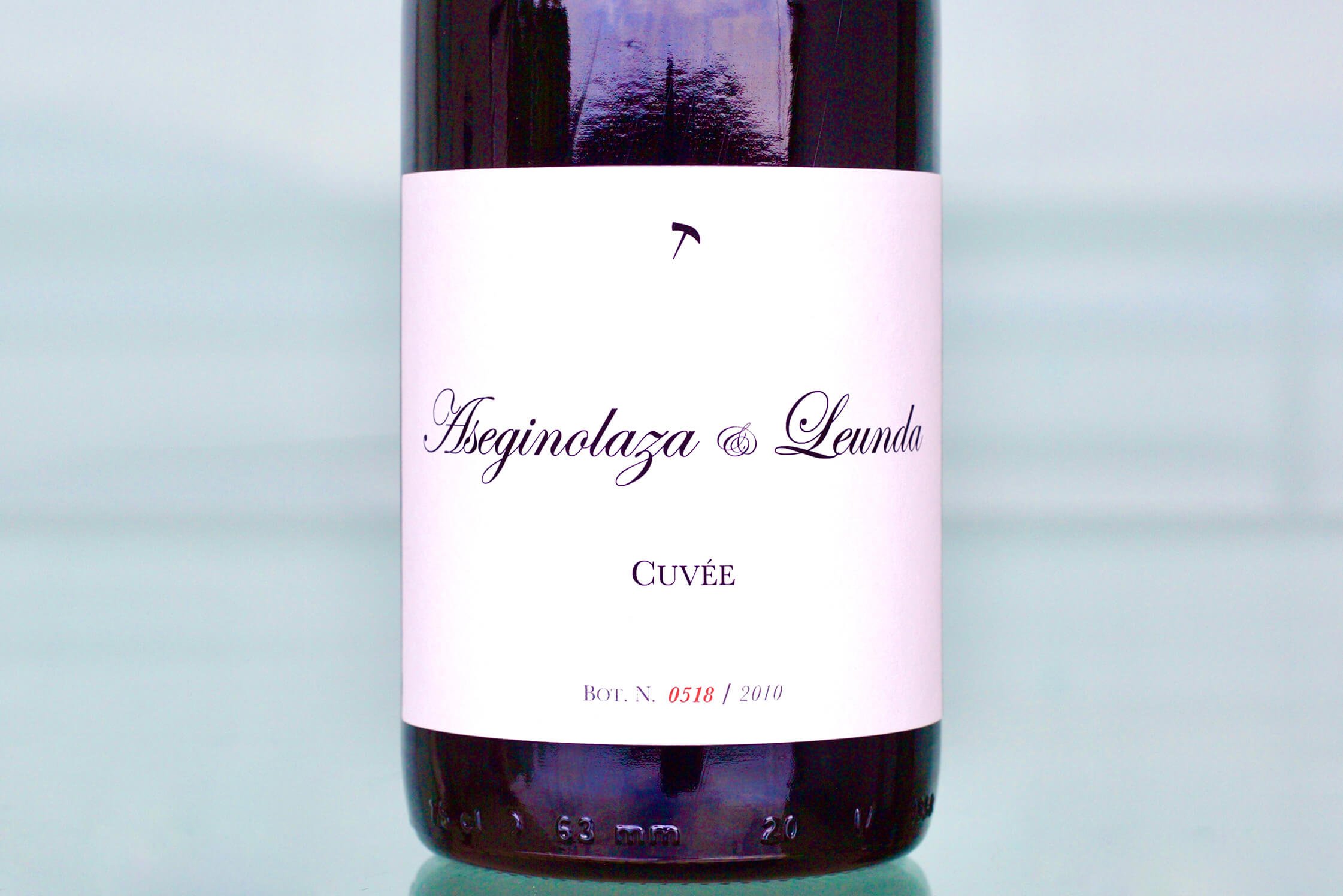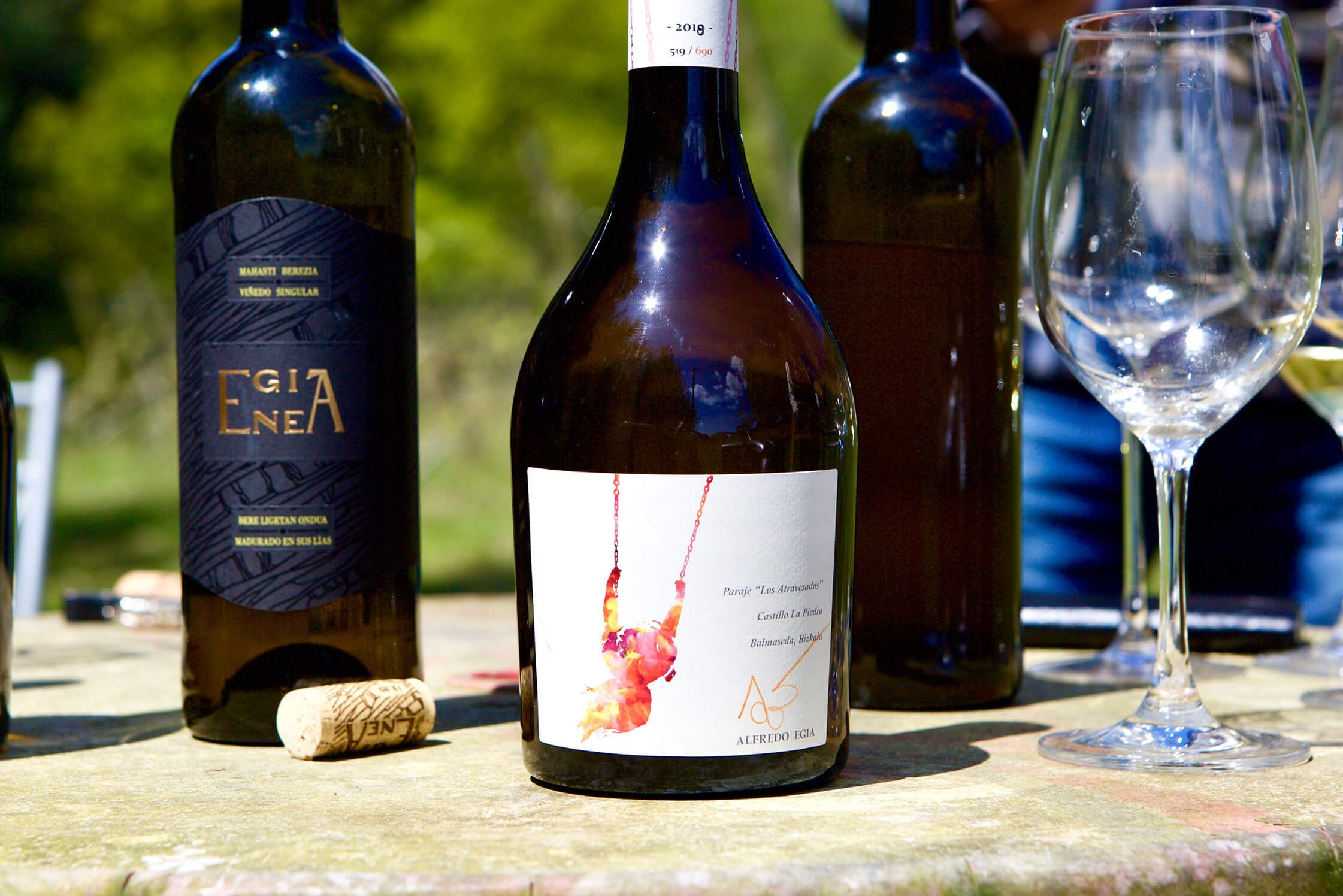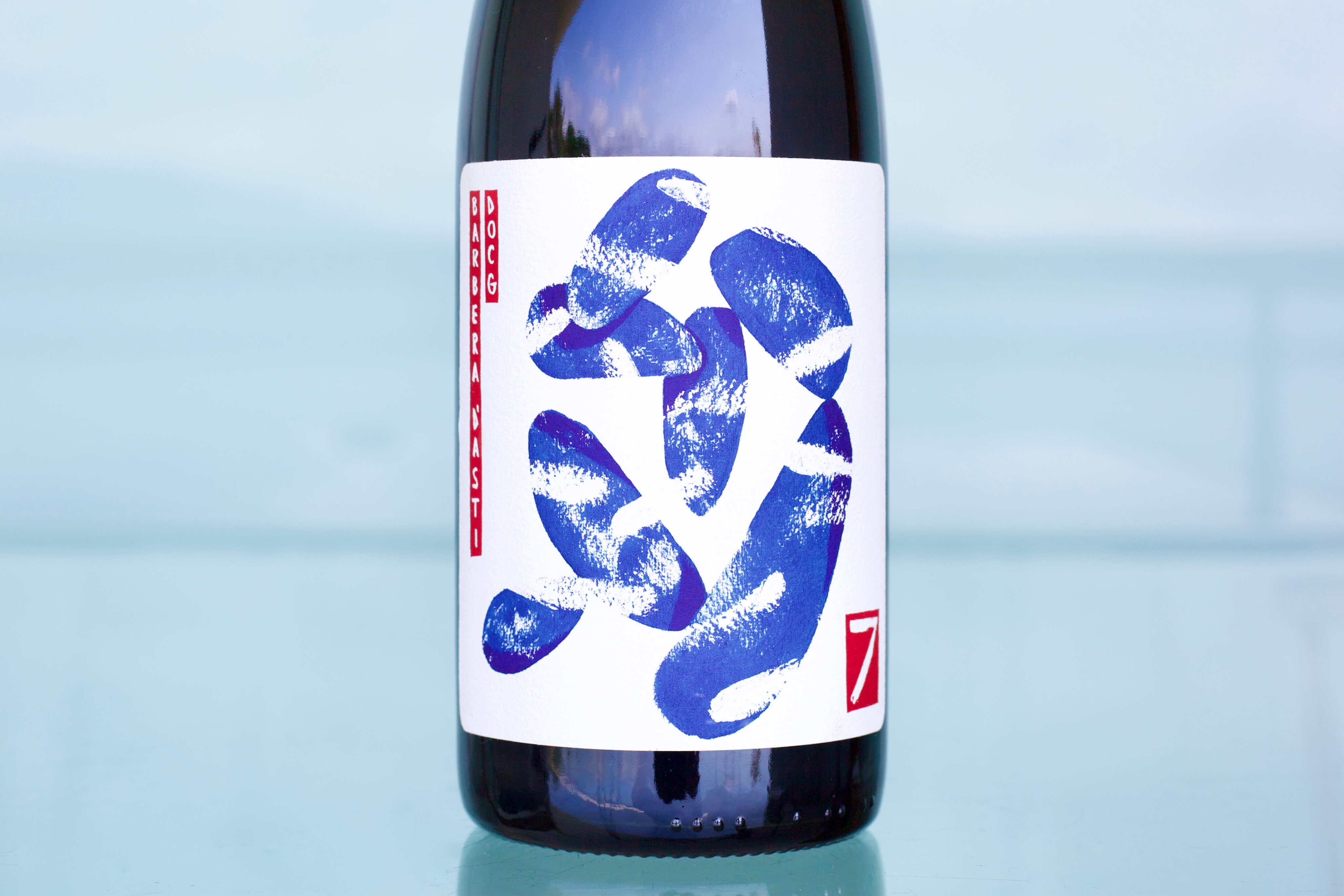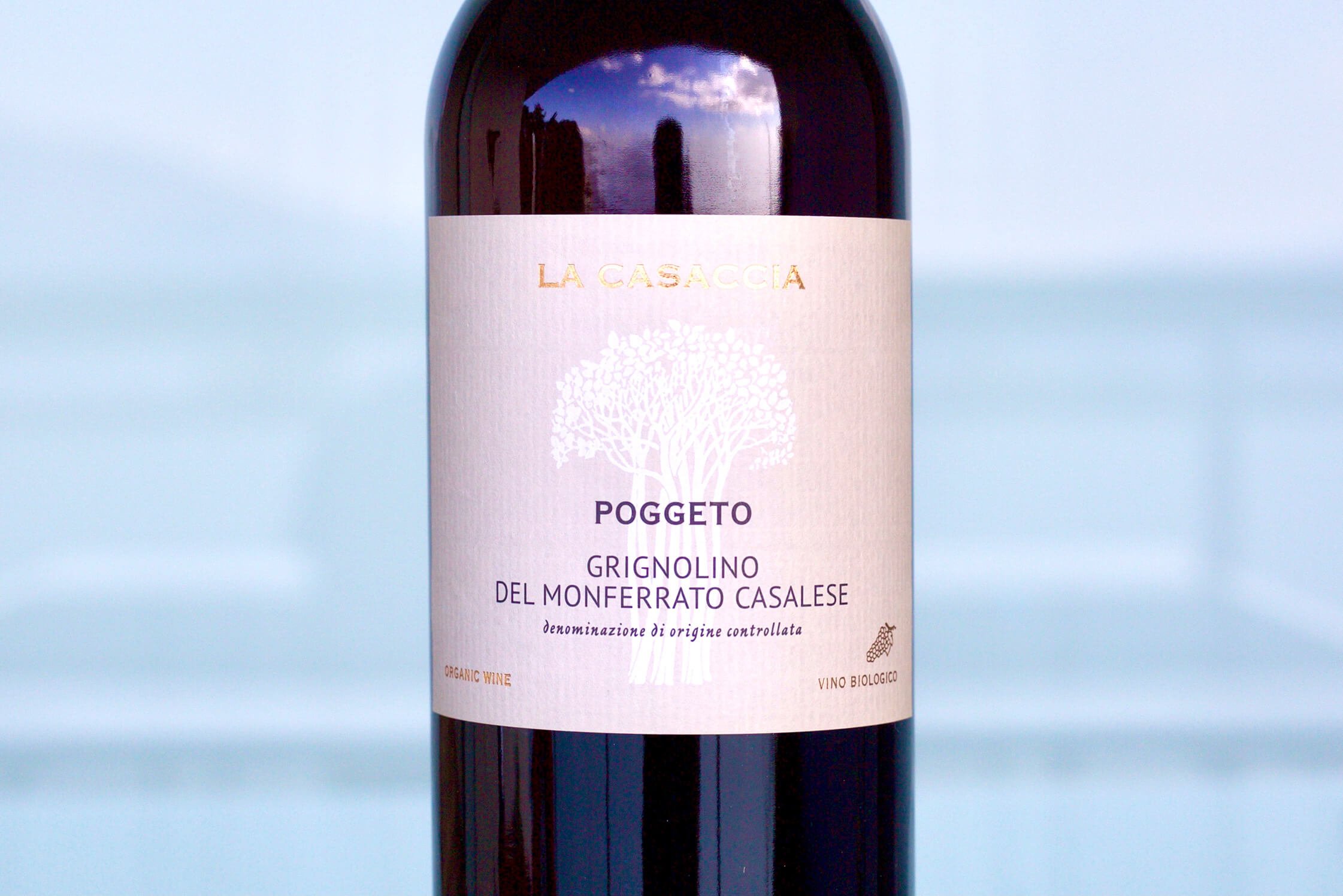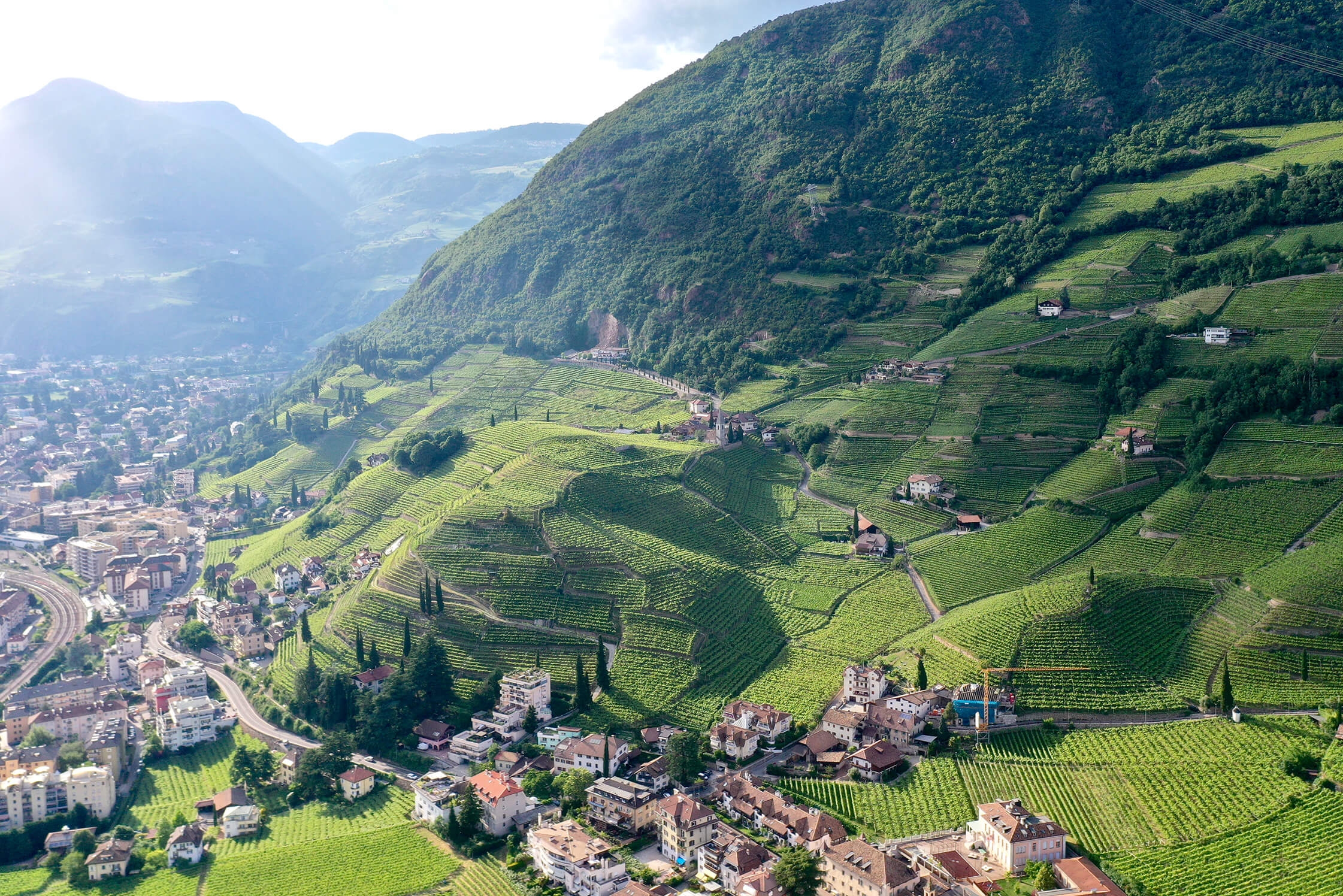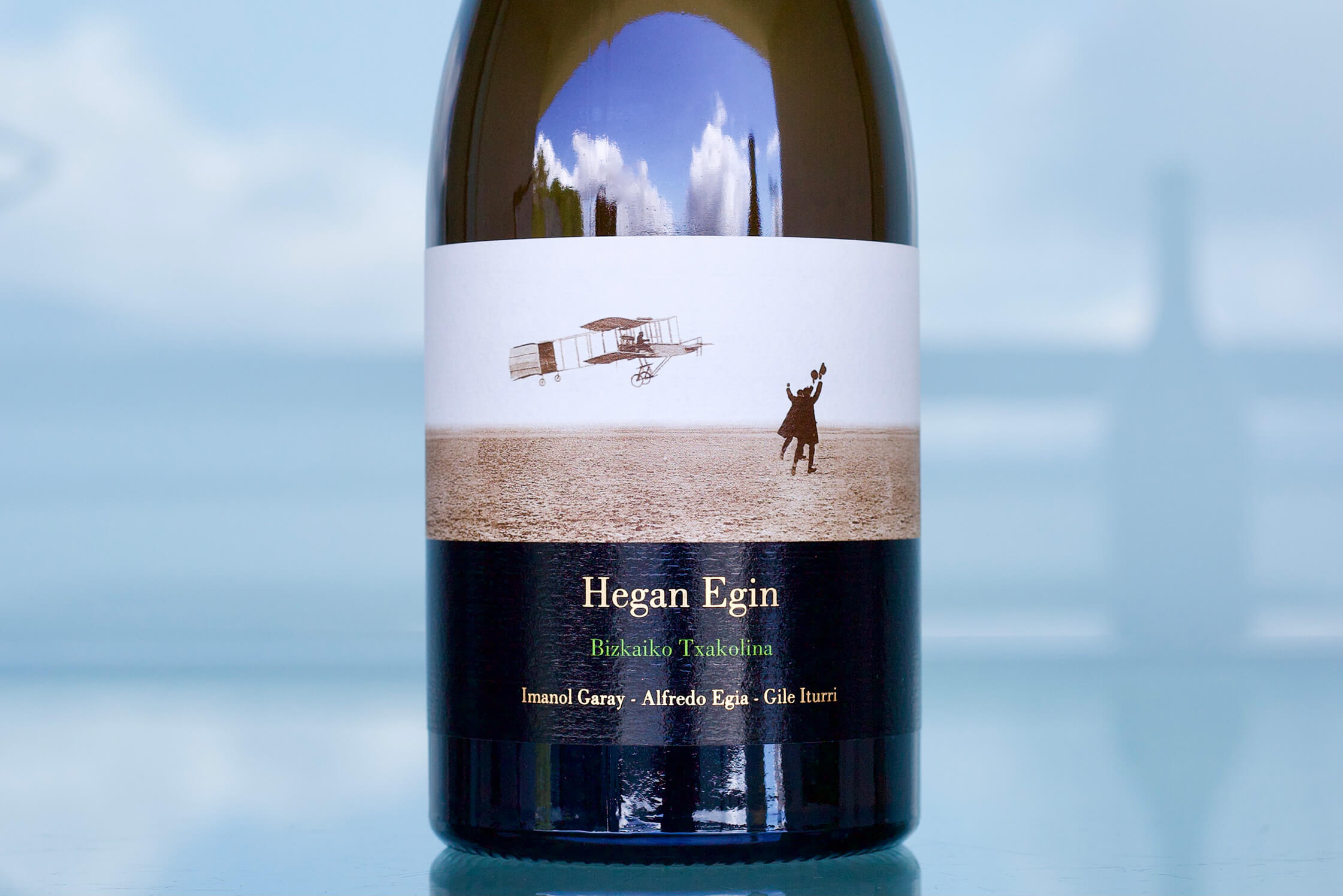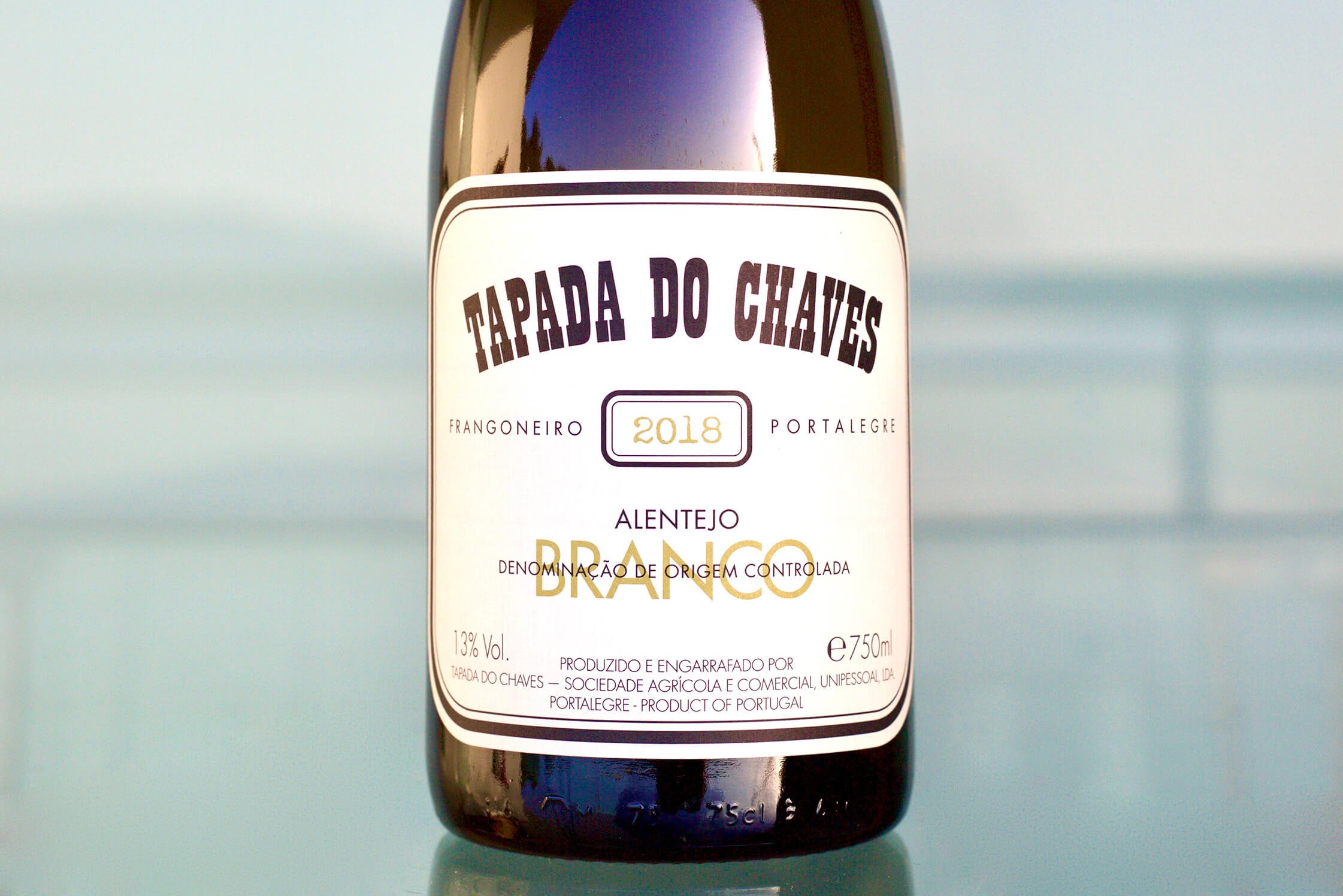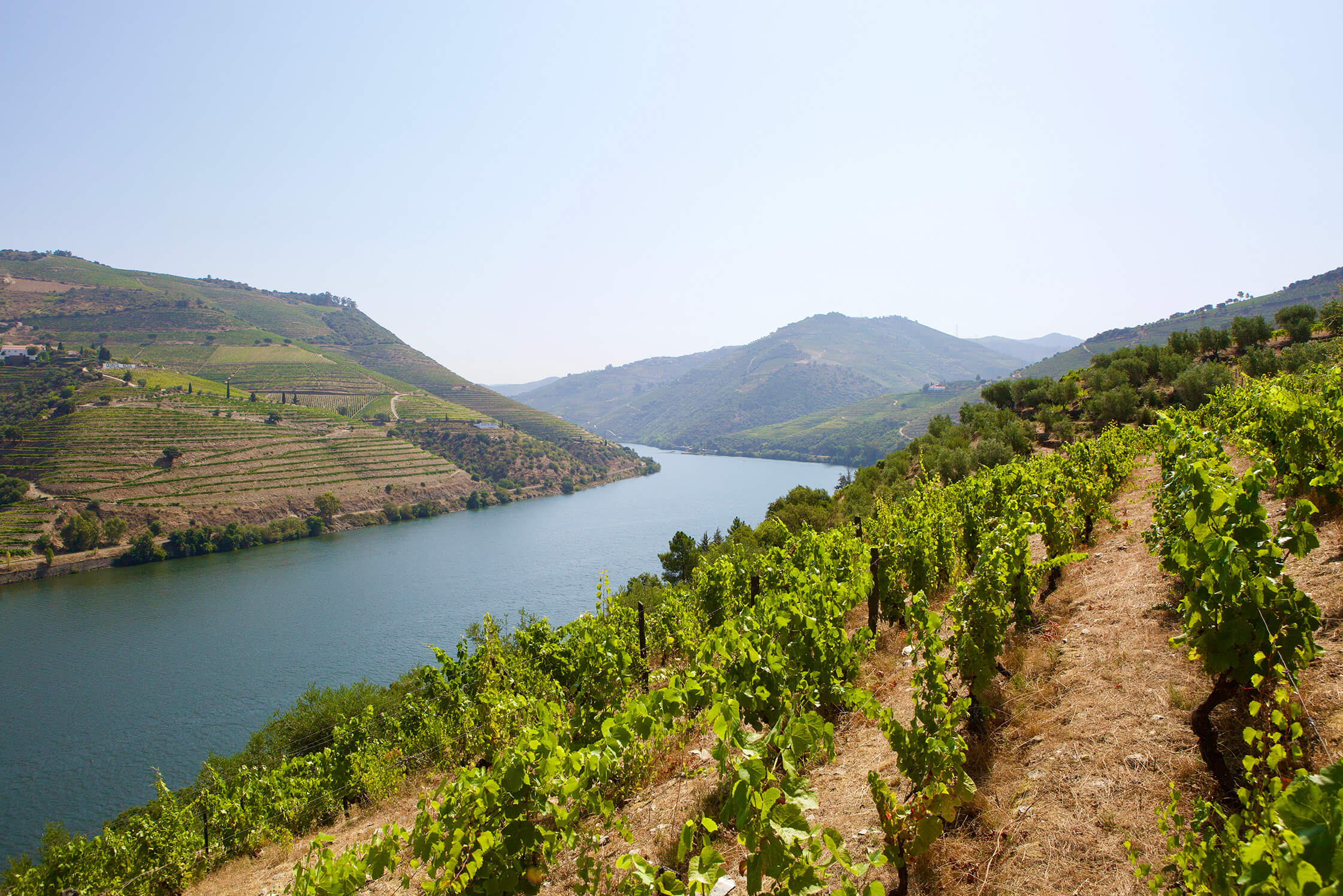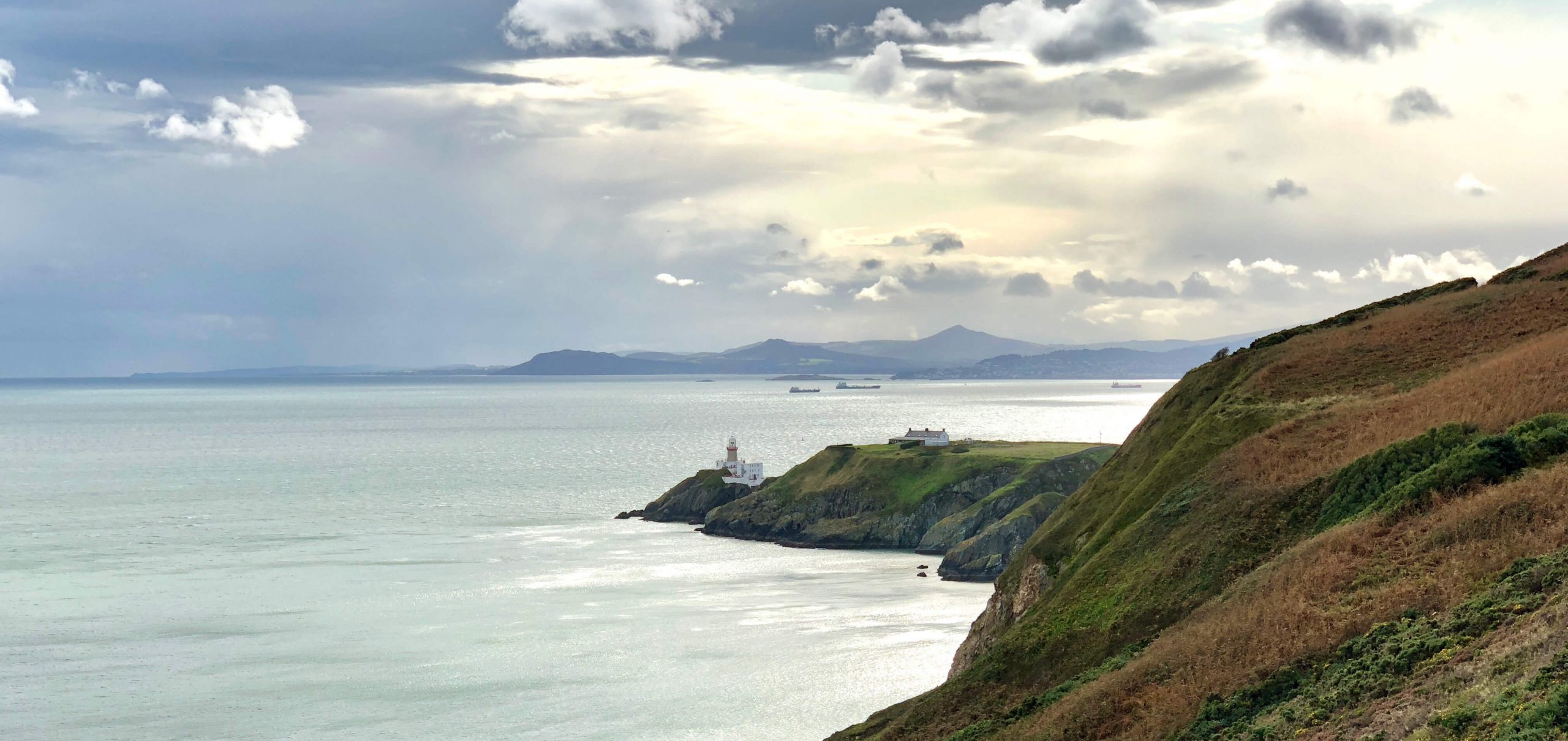
It’s been two years since I’ve been to the US and a lot has happened (including babies!). It will be nice to see all the faces I’ve missed and all the new people I’ve yet to meet in person. I’m especially happy that I’ll be seeing my father, who turned eighty this year and has gone through a rough patch with his health. It’s hard for us expats to have such a separation from our families for so long and I’m glad that the dry spell is coming to an end.
There’s a new terroir map this month: Galicia’s Rías Baixas, which also includes Portugal’s Vinho Verde sub-appellation, Monção e Melgaço, because of their common thread and focus on Albariño (Alvarinho, in Portuguese). It may be the most colorful map to date, action-packed, with information on rock types, grape codification, altitudes, temperatures, etc., all squeezed into one page.
In case you haven’t perused our website recently, there’s a new menu category of Videos that includes some interviews with winegrowers and some fun new drone videos of their land and regions. There are two posted so far and there will be many more to come.
The first drone video I did (which was more of a practice effort) is a regional teaser for our new producers in Spain’s Rioja and Txakoli areas, a short piece of eye-candy that covers some interesting ground from earlier this year. It’s fascinating how different the landscape in Rioja is compared to Txakoli, which is barely a half hour drive away from the northern parts of the region. The shots were filmed within a day or two of each other, but the drastically different environments make them seem like they are hundreds of miles apart.
The second video (which took me three days to edit because my efficacy with video is dismal) offers a tour of Chablis’ right bank. It’s a hair over ten minutes long, has classical music to accompany the flight, and a lot of information I’ve put in the form of text pop ups in the video to consider with the backdrop of the premier crus, Mont de Milieu, Montée de Tonnerre, and Fourchaume, and, of course, all the grand crus. The material may be slightly dense and sometimes a little fast to take it in one pass, but you can pause and rewind to read, check out the grooves in the landscape, refer to the accompanying vineyard map and contemplate the simplicity and complexity of this wine region.
When I am able to finally unplug myself from the unusually high quantity of new producer profiles I need to write for our website, I will get to the left bank of Chablis, along with dozens of other videos I plan to create from the drone footage I shot on my two-month trek through Europe, which only really missed the Loire Valley and Central and Southern Italy.
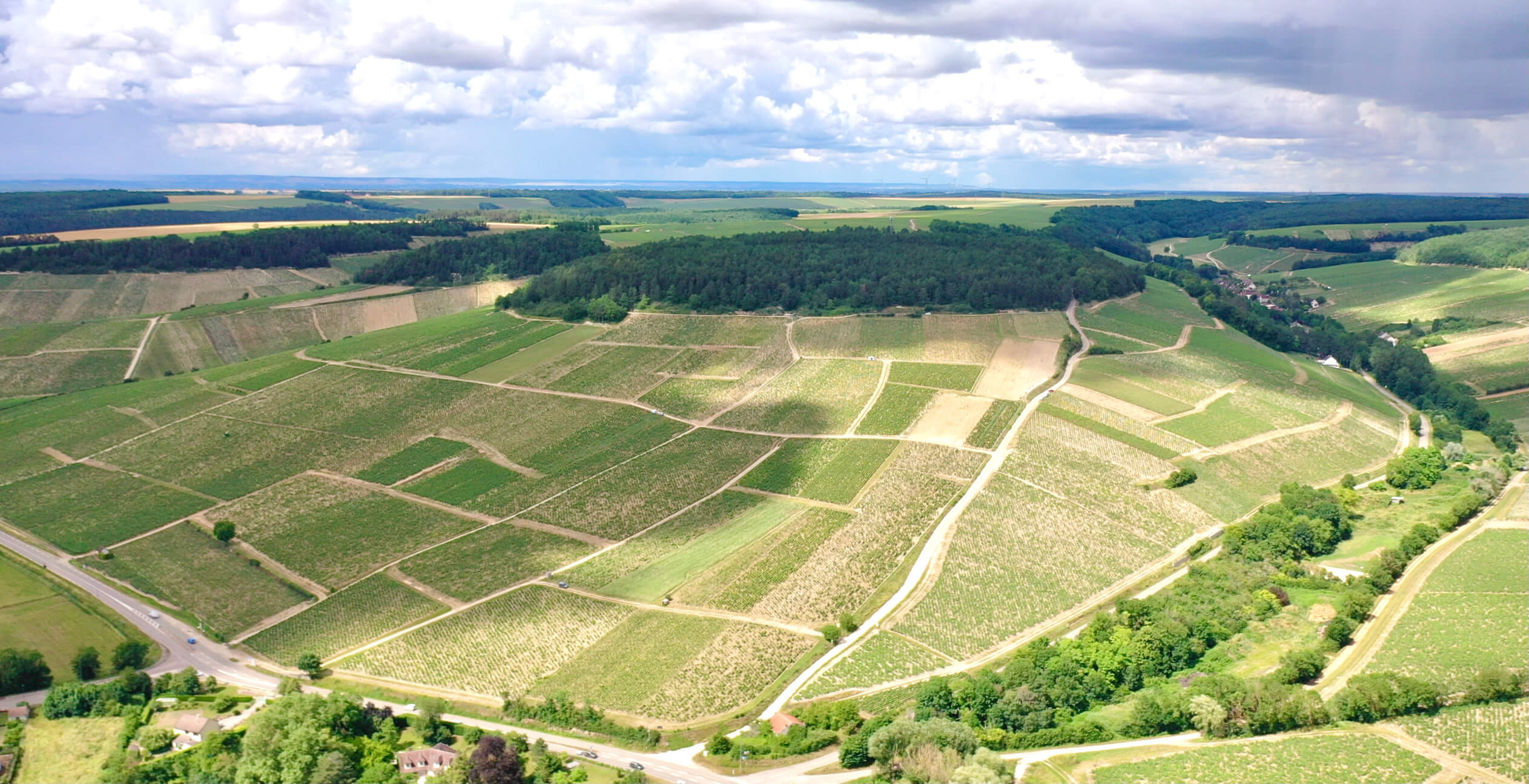
The logistics of this year have been by far the most difficult to navigate since we started our company a little over ten years ago, and things don’t seem to be getting better. Wines usually take about sixty days to get from the cellar door in Europe to California, but right now they can take up to five months… It’s for this reason that all the “new arrivals” coming in October were written about in our September newsletter because their original projections for arrival (even with a massive time buffer considered) were in that month and the end of August. Most of those wines did arrive on our shores, but the shore is where they stayed for two additional months. Getting them out of port in Europe was difficult enough, but they’ve been just floating out on the ocean close to the port waiting for the go-ahead to enter and unload. So, if you want to read about what new wines will actually be available this month, you can read (or review) our September newsletter.
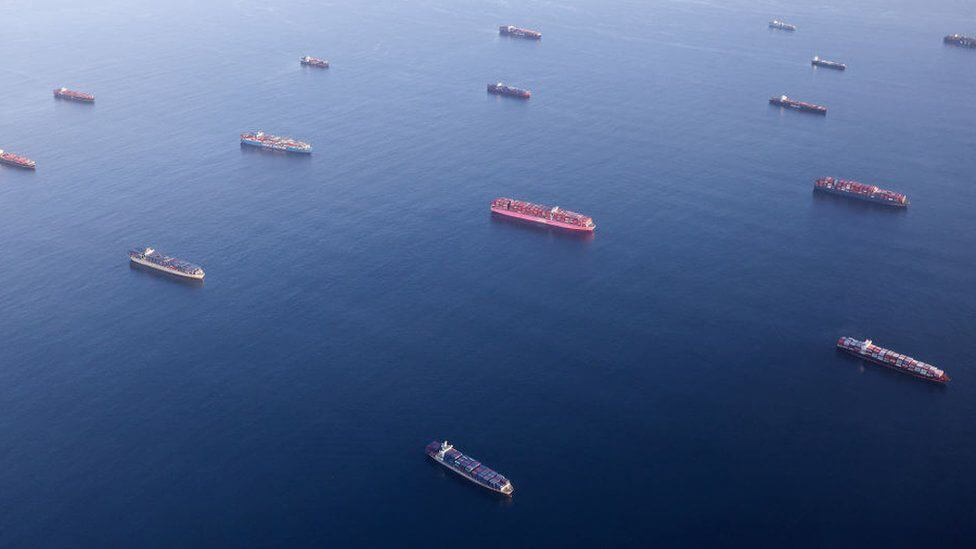
(Yes, as with a murder of crows, clowder is the name of a group of cats.)
For many, the pandemic was a waiting game. But for many others in business sectors such as delivery services, agriculture, and construction, they had an actual increase in business (at least over here, in Portugal). As the principal owner of our company, it was a call to action, as it was for most business owners. Sink or swim, right? My wife, Andrea, and I did more than just tread water, we were in an all-out freestyle race in search of new producers, redevelopment of some of our website ideas, online retail work (which saved our butts for many months at the beginning of the pandemic, paying our bills when the wholesale division had dropped to near zero), ramped up our foreign language classes, and tried to make sure that our employees were not sinking too far financially and going completely crazy with so much time to contemplate life and the stresses the pandemic caused for everyone.
During this unique moment in history, we greatly expanded into Iberia and picked up a few other producers in Italy, France and Germany along the way. Many of our new producers are not even close to arriving and I wanted to play them close to my chest until they got to the States because I’ve had bad experiences where people changed their minds and pulled out after we had already started to promote them. But given that this month all our new arrivals were already covered over the last two monthly newsletters, it’s a good opportunity to talk about some great new things in the market, and what’s more exciting than that?
What follows are short overviews of the upcoming new producers (with less personal narrative than usual) that can be found on our website. For some of these producers, it will be their first time being imported to the US.
What follows are short overviews of the upcoming new producers (with less personal narrative than usual) that can be found on our website. For some of these producers, it will be their first time being imported to the US. Incoming new producers mentioned in previous newsletters to arrive in October include Davide Carlone (Boca, Italy), Falkenstein (Südtirol, Italy), Togni-Rebaioli (Lombardy, Italy), La Battagliola (Lambrusco, Italy), and Elise Dechannes (Champagne, France).
The German organic (certified) and biodynamic winegrower, Katharina Wechsler, is the owner of enviable holdings in the most famous dry Riesling area of the Rheinhessen (thanks to the local luminaries, Klaus-Peter Keller, and Philipp Wittman), the highlights in her stable include a big slab of the grand cru vineyard, Kirchspiel, and a small chunk of perhaps the most coveted of all recognized grand crus, Morstein.
Between these two juggernaut vineyards of dry Riesling, her family owns entirely a large vineyard, called Benn. Only the upper section of Benn on the strongly calcareous sections is planted to Riesling, while much of the lower slopes are a patchwork of many different grape varieties that she loves to play with in her cellar, concocting things that range between pure pleasure and fun, savory orange wines, to more serious classically styled dry wines, like her knockout Scheurebe. The entry-level trocken Riesling will give any dry Riesling in all of Germany a run for the money but showcases the lifted and elegant exotic characteristics of Riesling only found in this part of the world.
Artuke’s Arturo Miguel is a quiet but influential leader of a new movement of young Spanish vignerons in Rioja, the country’s most historically famous region. The agenda is to bring attention back to specific terroirs and return the power to the growers themselves. He is the second generation of his family to grow and bottle their own wines since the end of the dictatorship, and when he took control of the family’s vineyards, he converted them all to organic farming.
His cellar techniques are straightforward, with older barrels of different shapes and sizes that highlight the differences between the four specific vineyard wines, except for the ARTUKE bottling made with carbonic maceration, a long-standing tradition with local wines, and Pies Negros, Spanish for black feet, a reference to the foot-stomping of the grapes, which is a blend of many different parcels. All wines come from calcareous sandstone (similar in structure and mineral makeup to sandstones from Barolo and Barbaresco) with varying degrees of sand and clay.
The young and open-minded José Gil and his Uruguayan life partner, Vicky, are major influencers in the new generation of Rioja grower-producers focused on single-site, organically farmed wines. Located near Rioja Alta’s famous San Vicente de la Sonsierra, most of the vineyards sit at higher altitudes that stretch the limitations of the region’s naturally long ripening season. Employing straightforward cellar practices with fermentation and aging in small to medium-sized barrels, José’s wines are direct, aromatic, fully flavored and driven by each wine’s terroir. José gives weight to the influence of the surrounding area, mostly from the mountains just to the north, and handles the wines gently to retain the area’s identity beyond the vineyards. The production is minuscule but on the rise.
Well-known and highly respected architect turned winegrower, Javier Arizcuren is one of Rioja Oriental’s most exciting new talents. With the help of his father, Javier spends his “spare time” focused on rescuing high-altitude, ancient Grenache and Mazuelo (the local name for Carignana) vineyards that managed to survive both phylloxera and the trend of replacing historic vines with Tempranillo, an early-ripening grape that is only a small part of this region’s history despite its dominance today. His experience with architecture leads him down rabbit holes of possibility and experimentation (a rarity in this often predictable and extremely conservative wine region), so that he may better understand the aesthetic of each site and build on its strengths using various fermentation and aging techniques.
Environmental biologists and former winemaking hobbyists, Jon Aseginolaza and Pedro Leunda, have directed their full attention to a project focused on a better understanding of Spain’s Navarra, a historical region with a severe identity crisis stemming from its living in the shadow of its illustrious neighbor, Rioja, Spain’s historical crown jewel. Always the bride’s maid and never the bride, the region began to focus on international varieties to stand out and increase its market share. Moving in the opposite direction of this trend, Jon and Pedro are focused on finding and recovering old vineyards planted with indigenous ancient genetic material (mostly Grenache, the historic grape of the region) inside vastly biodiverse areas—all assets that give the region a possible edge on the widely monocultural approach of much of Rioja. The life and authenticity in their first wines (started in 2017) are clear and their future is promising.
The wines made in Txakoli by Alfredo Egia are radical for the region but not for the world, since he is fully committed to biodynamic farming and natural wine methods. And with the influence of Imanol Garay, the highly intense and fully committed naturalist from France whom he refers to as his mentor, he’s determined to harness the intense energy of Izkiriota Txikia (Petit Manseng) and Hondarrabi Zerratia (Petit Courbu) to give them an altogether different expression, shape and energy, with a constant evolution upon opening that can last for days.
These white wines walk the line with no added sulfur and should be consumed earlier in their life to ensure captivity of their best moment. Whether they can age well or not remains to be seen, but since they have very low pH levels that usually sit below 3.20, and ta levels that can be well above 7.00, they should be insulated for a while. Rebel Rebel is the solo project of Alfredo, and Hegan Egin a joint venture between Alfredo, Imanol and Gile Iturri. Rebel Rebel is a blend of 80% Hondarrabi Zerratia and 20%Izkiriota Txikia. Hegan Egin is a blend of 50% Hondarrabi Zerratia and 50%Izkiriota Txikia
Asti is Piemonte’s new wine laboratory, and experimentation is extensive at Sette where they’re looking to expose new dimensions of their local indigenous varieties. The comedic and talented duo of the experienced wine trade pro, Gino Della Porta, and well-known enologist, Gianluca Colombo, founded Sette in 2017 with the purchase of a 5.8-hectare hill in Bricco di Nizza, in Monferrato. Immediately, a full conversion to organic farming began, followed by biodynamic starting in 2020—the latter, a vineyard culture still considered somewhat radical in these parts. The wines are crafted and full of vibrant energy with only a soft polish, with the focus, the slightly turbid and lightly colored, juicy fruity, minerally Grignolino and their two serious but friendly Barberas. Sette’s game-changing progressive approach and delicious wines (with total eye candy labels) should ripple through this historic backcountry and bring greater courage to the younger generations to break out of the constraints of the past and move full throttle into the future.
Even in Italy it may be impossible to find a vignaiolo who emits as much bubbling enthusiasm and pure joy for their work than La Casaccia’s Giovanni Rava. La vita è bella for Giovanni and Elena Rava, and their children, Margherita and Marcello. Working together in a life driven by respect for their land and heritage, they also offer accommodations in their restored bed and breakfast for travelers looking for a quieter Italian experience.
Their vines are organically farmed and scattered throughout the countryside on many different slopes with strong biodiversity of different forms of agriculture and untamed forests teeming with wild fruit trees (with the best of all, the cherries!). Their traditionally crafted range of wines grown on soft, purely calcareous sandstones and chalk are lifted, complex and filled with the humble yet exuberant character of the Rava family.
Martin Ramoser is a true budding young superstar in the wine world, and with the help of his parents, Stefan and Astrid, he’s writing a new chapter in the family’s wine history. Located in Italy’s Südtirol, only a half hour drive from the Austrian border, on the gorgeous and historical hill of Santa Magdalena that overlooks the city center of Bolzano, they cultivate their Schiava and Lagrein vineyards under organic and biodynamic principles. Their mere three hectares of vineyards are all planted on hillsides of porphyry, an igneous volcanic rock with a mix of large and small grain sizes, which makes for sandy, gravelly soils as it decomposes, and results in wines with higher aromas and chewy textures. Martin’s style is one of pleasure led by upfront aromatic red fruits and red/orange flowers with sharper lines, deep but gentle mineral textures and a soft touch on extraction.
Spanish/French former engineer, Imanol Garay, un vigneron libre, follows no wine rules (other than some labeling requirements for his French/Spanish wine blends) and believes in terroir not only as the concept of specific site or even region but as a contiguous philosophical thread practiced in different places that may be forged into one wine. A resident of southwest France, his cellar is in Orthez, only a short drive from Spain’s Basque country. Before starting his project, he worked with French natural wine gurus Richard Leroy and Vincent Carême, among others. Some vineyards are his own, some he rents and farms, and some fruit comes from friends with the same deep respect for nature.
He has another project in Spain’s Txakoli region with friends, Alfredo Egia (also in our portfolio) and Gile Iturri, labeled Hegan Egin; some years he makes Rioja, others Navarra, and always a lot of French wine. Cautiously walking the natural wine line, his pursuit is of the clean yet uninhibited, void of unwanted animally smells (the mouse, the horse), but with wonderful character-filled and potently nuanced, high-energy wines filled with joy and authenticity, just like the man himself.
There are few Portuguese wineries as mythical as Tapada do Chaves. Its line of extraordinary successes produced from vines planted in 1901 and 1903 by Senhor Chaves fell off the map when they were sold in the 1990s to a sparkling wine company. The property’s fortune changed with its purchase in 2017 by Fundação Eugénio de Almeida under the direction of Pedro Baptista, one of Portugal’s most celebrated oenologists most famously known for producing Pera Manca, some of the country’s most prized (and expensive) wines. Immediately these historic vineyards planted on a unique granite massif that towers over the flatter lands more typical of Alentejo below were converted to biodynamic farming, priming Tapada do Chaves to reassert itself as one of Portugal’s most preeminent terroirs. The white wines are blends of Arinto, Assario, Fernão Pires, Tamarez, and Roupeiro, with the reds Trincadeira, Grand Noir, Aragonez, and Alicante Bouschet.
The Douro property that was once in the hands of California trailblazing winemaker, Jerry Luper, (whose illustrious wine career included tenures at Chateau Montelena, Bouchaine, and Rutherford Hill), has been for years now under the ownership of Luis Candido da Silva, a well-known wine retailer in Porto. Today, the winery has been slowly taken over by his son, also named Luis, and things are going through some noticeable changes the more Luis Jr. commits himself to the project. His day job is working as the head enologist and wine director for the still Douro wine program at Dirk Niepoort’s ever-expanding, global wine empire. Niepoort has a history of recognizing talent and churning out many superstars in Portugal, most notably Luis Seabra, the boys over at Arribas Wine Company (also in our portfolio), and starting in 2018, Luis Jr. The respect he has garnered at a very young age in Portugal speaks volumes for the confidence the local wine world has in him. Exciting things are in store for this very small estate with wines that cover both the traditional style like his father’s, and the extreme progressivism of his generation, with a gorgeous touch, exquisite crafting, and a razor-sharp attention to detail. Expect big things, albeit in very small quantities (unfortunately) from this special Quinta.■

